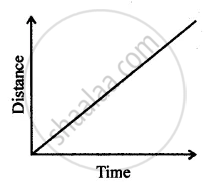Advertisements
Advertisements
प्रश्न
How can you find the following?
Displacement from velocity – time graph.
उत्तर
Displacement from velocity – time graph: Displacement covered by a body is equal to the area under velocity – time graph. When an object moves with a uniform velocity, the velocity – time graph is a straight line (PQ) parallel to the time axis.

Take any two points A and B on velocity – time graph.
From A and B, draw two perpendiculars AD and BC on the time axis such that
OD = t1 and OC = t2
Let OP = AD = BC = v = Velocity of the body.
Area under velocity – time graph = Area of rectangle ABCD
= AD × DC = v × (OC − OD) = v (t2 − t1)
= Displacement covered by the body
APPEARS IN
संबंधित प्रश्न
A farmer moves along the boundary of a square field of side 10 m in 40 s. What will be the magnitude of displacement of the farmer at the end of 2 minutes 20 seconds?
State whether distance is a scalar or a vector quantity.
Figure shows the displacement-time graph of two vehicles A and B moving along a straight road. Which vehicle is moving faster? Give reason.

When brakes are applied to a bus, retardation produced is 25 cm s-2 and the bus takes 20 s to stop. Calculate -
- The initial velocity of the bus
- The distance travelled by bus during this time.
Give an example of a body which covers a certain distance, but its displacement is zero.
Can you suggest the kind of motion of a body from the following distance – time graph?

Define displacement.
A particle moves along a circular path. How many times does it change its direction in two complete rounds?
An object is dropped from rest at a height of 150 m and simultaneously another object is dropped from rest at a height of 100 m. What is the difference in their heights after 2s if both the objects drop with the same accelerations? How does the difference in heights vary with time?
A scalar quantity has ______.
